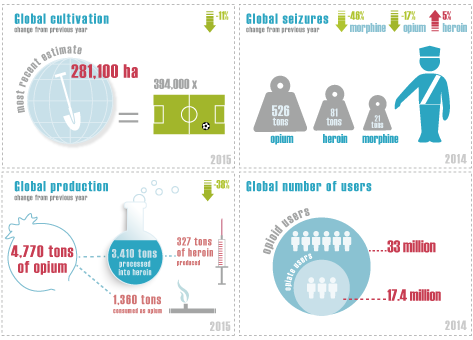

Primarily carried out in South-West Asia and, to a lesser extent, in South-East Asia and Latin America, global opium production in 2015 fell by 38 per cent from the previous year to some 4,770 tons, i.e., to the levels of the late 1990s. The decrease was primarily a consequence of a decline in opium production in Afghanistan (a decrease of 48 per cent from the previous year), mainly as a result of poor yields in the country's southern provinces. However, at 183,000 hectares, Afghanistan still accounted for almost two thirds of the global area under illicit opium poppy cultivation, which decreased by 11 per cent from the previous year to around 281,000 hectares.
UNODC estimates indicate that the global number of opiate users (i.e., users of opium, morphine and heroin) has changed little in recent years and that opiates continued to affect some 17 million people in 2014. It seems unlikely that the sharp decline in opium production in 2015 will lead to major shortages in the global heroin market given the high opium production levels of previous years. The build-up or depletion of previous years' opium inventories may be used to offset annual changes in production and maintain the supply of heroin to user markets. It may take a period of sustained decline in opium production for the repercussions to be felt in the heroin market.